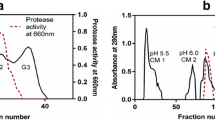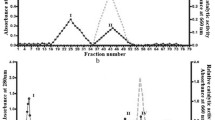Abstract
The current study was carried out to evaluate the pharmacological properties of cupincin- A novel cupin domain containing metalloprotease with limited proteolysis from rice bran on blood coagulation and hydrolysis of human fibrinogen. Cupincin preferentially hydrolyzed the Aα chain of fibrinogen and then the Bβ-chain, but not the γ-chain. Cupincin reduced the re-calcification time of citrated human plasma dose dependently. Analysis of citrated whole blood in the presence of cupincin by rotem showed a decrease in coagulation time and clot formation time. Sonoclot analysis indicated that cupincin cleaved fibrinogen of whole citrated blood. SDS-PAGE and sonoclot analysis (LI-30) indicated that cupincin lacked plasmin-like activity. Global hemostasis tests like rotem and sonoclot analysis determined cupincin as a procoagulant enzyme. Cupincin did not show any effect on prothrombin time and activated partial thromboplastin time tests suggesting its action on the common pathway of coagulation. The involvement of proteases from rice (Oryza sativa L.) in haemostasis has never been exploited before. This study could provide the basis for the development of new procoagulant agents from a nontoxic source like rice.





Similar content being viewed by others
References
Sreedhar R, Kaul TP (2016) Cupincin: a unique protease purified from rice (Oryza sativa L.) bran is a new member of the cupin superfamily. PLoS ONE 11(4):e0152819. doi:10.1371/journal.pone.0152819
Costa JO, Fonseca KC, Garrote FMS, Cunha CC, de Freitas MV, Silva S, Araújo RB, Penha SN, de Oliveira F (2010) Structural and functional comparison of proteolytic enzymes from plant latex and snake venoms. Biochimie 2:1760–1765
Rajesh R, Shivaprasad HV, Gowda RC, Nataraju A, Dhananjaya BL, Vishwanath BS (2007) Comparative study on plant latex proteases and their involvement in hemostasis: a special emphasis on clot inducing and dissolving properties. Planta Med 73:1061–1067
Richter G, Hans PS, Friedrich D, Peter L (2002) Activation and inactivation of human factor X by proteases derived from Ficus carica. Br J Haematol 119:1042–1051
Shivaprasad HV, Riyaz M, Kumar VR, Dharmappa KK, Tarannum S, Siddesha JM (2008) Cysteine proteases from the Asclepiadaceae plants latex exhibited thrombin and plasmin like activities. J Thromb Thrombolysis 28:304–308
Rajesh R, Gowda CD, Nataraju A, Dhananjaya BL (2006) Purification and characterization of a 34-kDa, heat stable glycoprotein from Synadenium grantii latex: action on human fibrinogen and fibrin clot. Biochimie 88:1313–1322
Salas CE, Gomes MTR, Hernandez M, Lopes MTP (2008) Plant cysteine proteinases: evaluation of the pharmacological activity. Phytochemistry 69:2263–2269
Satish S, Sairam F, Ahmed AU (2012) Moringa oleifera Lam: protease activity against blood coagulation cascade. Pharmacogn Res 4:44–49
Priyanka U, Raghu RA, Poojitha B, Rinimol VR, Bindu J, Zohara N, Nanjunda S (2015) Laticiferous plant proteases in wound care. Int J Pharm Sci 7:44–49
Bradford MM (1976) A rapid and sensitive method for the quantitation of microgram quantities of protein utilizing the principle of protein-dye binding. Anal Biochem 72:248–254
Ouyang C, Teng CM (1976) Fibrinogenolytic enzymes of Trimeresurus mucrosquamatus venom. Biochim Biophys Acta 420:298–308
Laemmli UK (1970) Cleavage of structural proteins during the assembly of the head of bacteriophage T4. Nature 227:680–685
Diganta D, Nanjaraj U, Vilas H, Bannikuppe SB, Robin D (2013) Biochemical and biological characterization of Naja kaouthia venom from North-East India and its neutralization by polyvalent antivenom. J Venom Res 4:31–38
Devaraja S, Girish KS, Devaraj VR, Kemparaju K (2010) Factor Xa-like and fibrin(ogen)olytic activities of a serine protease from Hippasa agelenoides spider venom gland extract. J Thromb Thrombolysis 29:119–126
Condrea E, Mammon Z, Aloof S, Devries A (1964) Susceptibility of erythrocytes of various animal species to the hemolytic and phospholipid spitting action of snake venom. Biochim Biophys Acta 84:365–375
Ferraris VA, Ferraris SP, Saha SP, Eugene AH, Constance KH, Royston BD, Charles RB, Higgins RSD, George D, Jeremiah RB (2007) Perioperative blood transfusion and blood conservation in cardiac surgery: The Society of Thoracic Surgeons and The Society of Cardiovascular Anesthesiologists clinical practice guideline. Ann Thorac Surg 83(5 Suppl):S27–S86
Hett DA, Walker D, Pilkington SN, Smith DC (1995) Sonoclot analysis. Br J Anaesth 75:771–776
Luddington R, Baglin T (2004) Clinical measurement of thrombin generation by calibrated automated thrombography requires contact factor inhibition. J Thromb Haemost 11:1954–1959
Lang T, Bauters A, Braun SL, Pötzsch B, Von Pape KW, Kolde HJ, Lakner M (2004) Multi-centre investigation on reference ranges for ROTEM thromboelastometry. Blood Coagul Fibrinolysis 16:301–310
Acknowledgements
We are grateful to Director, CSIR-Central Food Technological Research Institute (CFTRI), Mysuru, for his support and encouragement. The authors wish to thank Vilas Hiremath of Vijayashree diagnostic centre, Bengaluru for his help in Thromboelastometry and Sonoclot analysis. Roopesh S acknowledges the award of Senior Research Fellowship from Indian Council of Medical Research, New Delhi.
Author information
Authors and Affiliations
Corresponding author
Ethics declarations
Conflict of interest
The authors declare no conflict of interest.
Ethical Approval
This article does not contain any studies with human participants or animals performed by any of the authors.
Rights and permissions
About this article
Cite this article
Sreedhar, R., Tiku, P.K. Cupincin: A Novel Cupin Domain Containing Protease from Rice (Oryza sativa L.) Bran Comprising of Procoagulant and Fibrinogenolytic Activity. Indian J Hematol Blood Transfus 34, 314–321 (2018). https://doi.org/10.1007/s12288-017-0856-2
Received:
Accepted:
Published:
Issue Date:
DOI: https://doi.org/10.1007/s12288-017-0856-2




